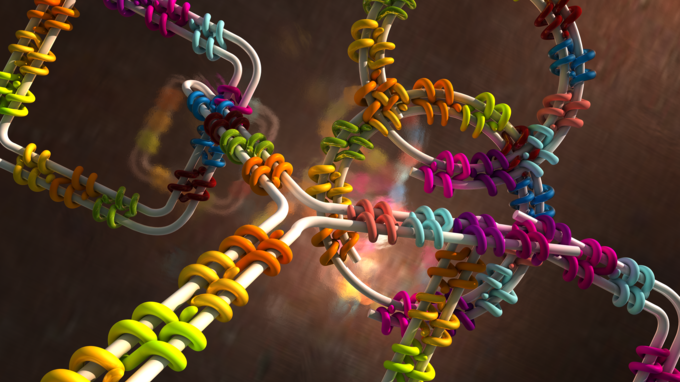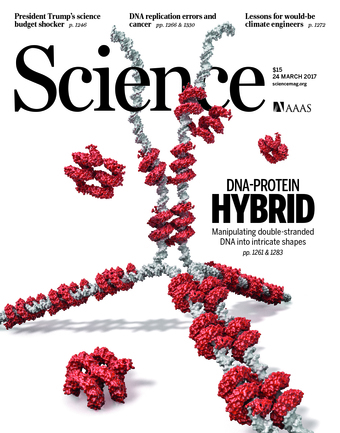Designer-Proteine falten DNA
Biophysiker konstruieren komplexe Hybridstrukturen aus DNA und Proteinen
2017-03-24 – Nachrichten aus dem Physik-Department

Desoxyribonukleinsäure – besser bekannt unter der englischen Abkürzung DNA – ist die Trägerin unserer Erbinformation. Für Prof. Hendrik Dietz und Florian Praetorius vom Lehrstuhl für Experimentelle Biophysik ist sie aber auch ein exzellentes Baumaterial für Nanostrukturen. Schon länger etabliert ist in diesem Zusammenhang das sogenannte DNA-Origami, bei dem DNA gefaltet wird, um damit dreidimensionale Formen zu erzeugen.
Doch bei dieser Methode gibt es Einschränkungen, erklärt Dietz. Denn die “Bauarbeiten” finden immer außerhalb des biologischen Systems statt und Teile der Komponenten müssen chemisch synthetisiert werden. “Es ist ziemlich schwierig, benutzerdefinierte Strukturen in der Größenskala von 10 bis 100 Nanometern innerhalb einer Zelle zu schaffen.” Mit der neu entwickelten Technik ist es den Forschern nun möglich, doppelsträngige DNA mithilfe von Proteinen in gewünschte dreidimensionale Formen zu falten, wobei sowohl die DNA als auch die dafür nötigen Proteine genetisch codiert und in Zellen produziert werden können.
Protein wirkt als Tackerklammer
Der Schlüssel für die Methode sind speziell entworfene “Klammer-Proteine”, die auf den sogenannten TAL-Effektoren basieren. TAL-Effektoren werden in der Natur von bestimmten Bakterien produziert, die Pflanzen infizieren, und haben die Fähigkeit, sich an spezifische Sequenzen in der Pflanzen-DNA zu heften und damit unter anderem Abwehrmechanismen der Pflanzen lahmzulegen. “Wir haben Varianten der TAL-Proteine konstruiert, die zwei getrennte durch den Designer definierte Ziel-Sequenzen auf der DNA erkennen und quasi zusammentackern können”, sagt Dietz. “Das war genau die Eigenschaft, die wir für unsere Klammer-Proteine gebraucht haben.”
Die zweite Komponente des Systems ist ein DNA-Doppelstrang, der mehrere Bindesequenzen enthält, die von einem Satz verschiedener Klammer-Proteine erkannt und verknüpft werden können. “Im einfachsten Fall kann man eine Schleife erzeugen, indem man zwei Punkte miteinander verbindet”, erklärt Praetorius. “Wenn mehrere dieser Verknüpfungspunkte in der DNA vorhanden sind, ist es möglich, auch komplexere Formen zu bauen.” Ein wesentlicher Teil der Arbeit der Forscher lag daher darin, ein Regelwerk zu bestimmen, wie die Klammerproteine selber sowie die Verteilung der Bindesequenzen auf dem DNA-Doppelstrang gestaltet sein müssen, um gewünschte Formen zu erzeugen.
Neue Werkzeuge für die Grundlagenforschung
Die Klammer-Proteine dienen darüber hinaus auch als Ankerpunkte für weitere Proteine: Durch eine Methode, die sich genetische Fusion nennt, können beliebige funktionelle Proteindomänen angeheftet werden. Die Hybridstrukturen aus DNA und Proteinen dienen damit als dreidimensionales Gerüst, mit denen die anderen Proteindomänen in eine bestimmte räumliche Position gebracht werden. Alle Bausteine für die DNA-Protein Hybridstrukturen können von der Zelle selbst hergestellt werden und setzen sich dann eigenständig zusammen. Die Forscher konnten die Hybride in zellähnlicher Umgebung ausgehend von genetischer Information herstellen. “Die Wahrscheinlichkeit ist recht hoch, dass das auch in Zellen funktioniert”, sagt Dietz.
Die neue Methode eröffnet einen Weg, die räumliche Anordnung von Molekülen im lebenden System zu kontrollieren. Damit können grundlegende biologische Prozesse untersucht werden. Zum Beispiel wird vermutet, dass die räumliche Anordnung des Genoms einen Einfluss darauf hat, welche Gene abgelesen werden können und mit welcher Effizienz dies geschieht. Die gezielte Erzeugung von Schlaufen über TAL-DNA-Hybridstrukturen in genomischer DNA stellt ein Werkzeug zur Verfügung, mit dem solche Prozesse untersucht werden können. Auch könnten eine Reihe von Proteinen innerhalb und außerhalb der Zelle in gewünschter Weise geometrisch positioniert werden um den Einfluss der räumlichen Nähe etwa auf die Informationsverarbeitung in der Zelle zu untersuchen. Die räumliche Nähe bestimmter Enzyme könnte auch Prozesse in der Biotechnologie effizienter machen. Schließlich wäre es auch denkbar Protein-DNA-Hybridstrukturen heranzuziehen, um zum Beispiel die Immunantwort von Zellen besser zu stimulieren, die von geometrischen Anordnungen von Antigenen abhängen kann.
Das Projekt wurde finanziert durch das Bundesministerium für Bildung und Forschung im Rahmen des ERANET SynBio Programms “BioOrigami”, sowie durch das Gottfried-Wilhelm-Leibniz Programm der DFG, und durch die Exzellenzcluster CIPSM und NIM.
- Desk
- Stefanie Reiffert, Dr. Johannes Wiedersich
Veröffentlichung
Verwandte Meldungen
- Auf der molekularen Streckbank – 2017-02-24
- Zwei weitere ERC-Grants ans Physik-Department – 2016-12-23
- Kräftemessen im Erbgutmolekül – 2016-09-12
- Nanorotor und -greifer bringen DNA-Origami einen großen Schritt weiter – 2016-03-04
- Biophysiker Hendrik Dietz (36) erhält deutsche Spitzenauszeichnung – 2014-12-10
Links
Kontakt
- Prof. Hendrik DietzTechnical University of Munich+49 (0) 89 289-11615
